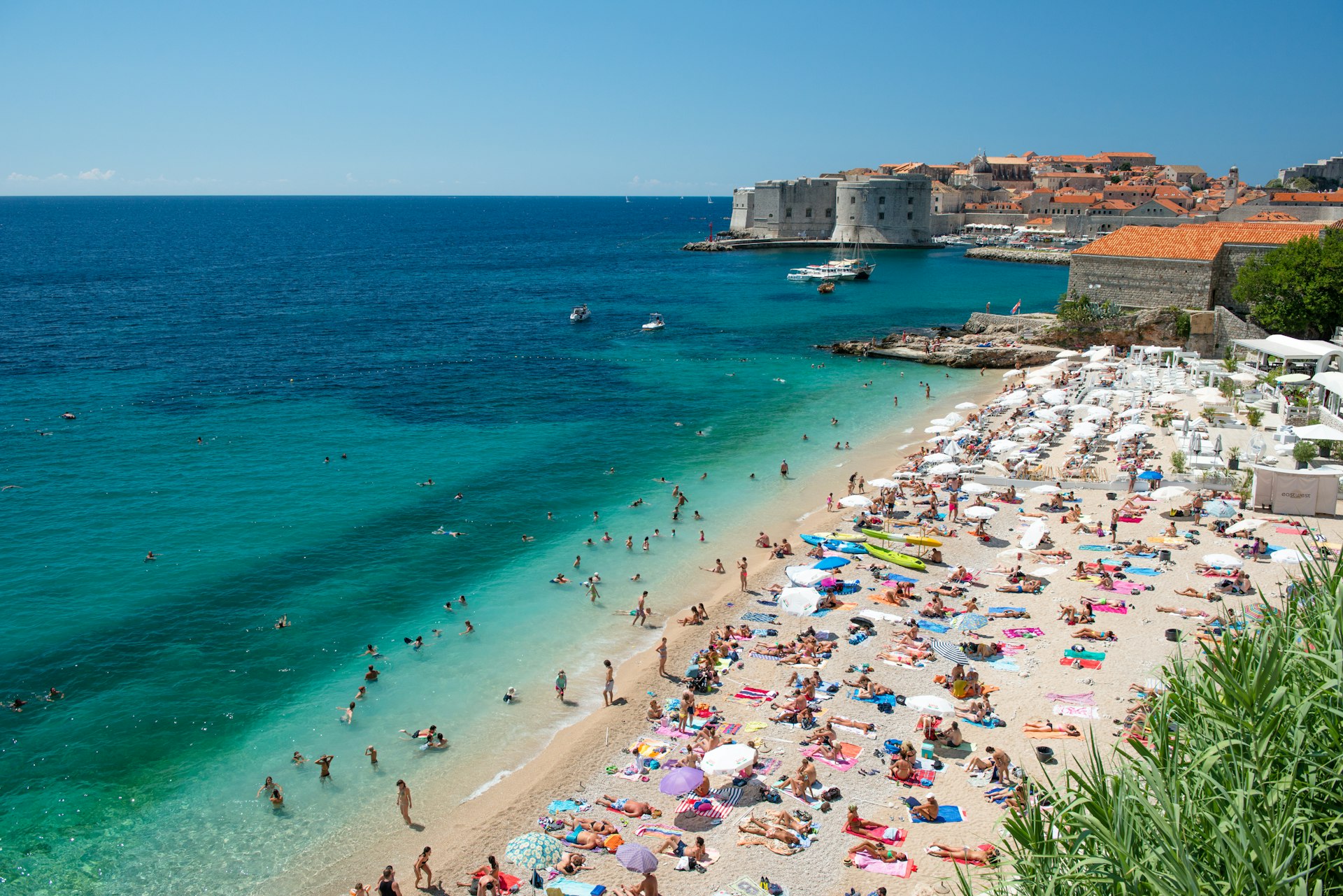If you’re planning a trip in 2024, be prepared for a few unforeseen expenses. A growing number of destinations worldwide are collecting a tax on tourists – a fee that’s often added to hotel bills or charged upon arrival.
Tourism taxes are nothing new. Bolstering local economies by targeting out-of-towners has long been commonplace everywhere from New York to New Zealand. According to a 2020 report by Group NAO and GDS-Movement, the practice has grown in popularity over the past decade – particularly in the US and Europe.
A few reasons explain the tax uptick, explains Guy Bigwood, one of the report’s authors and “chief changemaker” at the Global Destination Sustainability Movement. More destinations are creating sustainability initiatives – and to reach their green goals, they need additional funding. “Tourism taxes and especially assessments or levies can help with this,” Bigwood says.
Travel to popular locales has also bounced back to pre-pandemic levels, reigniting “tourismphobia”: the fear, anxiety and rejection of unsustainable tourism practices. “Tourism taxes and assessments are being considered as a tool to control numbers,” he adds.

Bigwood believes the overwhelming success of this international money grab means the practice is here to stay. Visitor-generated revenue shifts some of the tax burden from residents to foreigners, mitigating the impacts of overtourism and improving the quality of local life.
In Greece, a hike in an existing hotel tax will help fight natural disasters caused by climate change. In Dubrovnik, a tariff imposed on cruise ships will help improve the ancient city’s infrastructure.
Most of these taxes are nominal – and shouldn’t be a deterrent to travelers. “Actually, we are seeing that tourists and businesses are happy to pay a levy if they know the money will be well spent in their community,” says Bigwood.
Still, costs can add up. Which is why we’ve rounded up all the places that have recently added, increased, or have plans to change their tourism taxes in 2024.
Here are the destinations that’ll cost you extra this coming year – and how officials plan to use your money.

Amsterdam, Netherlands
Amsterdam’s tourism tax is already Europe’s highest. And in 2024, the Dutch city plans to up the ante, with government officials increasing hotel room tax from 7% to 12.5%. The tariff for cruise-ship passengers will also rise from €8 (roughly $8.73) to €11 (roughly $12) per person per day.
“Visitors will thus help to pay for the city to carry out its tasks,” Hester van Buren, Amsterdam’s deputy mayor for finance, said in a statement. “This allows us to address the consequences of overtourism and direct additional resources to keeping the streets clean and solving acute problems in neighborhoods and districts.”
Bali, Indonesia
Starting on February 14, 2024, non-Indonesian visitors to Bali will pay a per-person fee of 150,000 IDR (roughly $10). Visitors can make payments in rupiah or by credit card at one of five designated payment counters at Bali Airport’s international arrivals hall.
Officials say the tourism tax will be used for cultural and environmental protection.
Barcelona and Valencia, Spain
Barcelona will increase its municipal tourism tax in April 2024, impacting travelers staying in government-regulated tourist accommodations. The surcharge is an addition to the regional tax imposed by Catalonia since 2012.
The fee, currently €2.75 per night, will increase to €3.25, only paid for the first seven consecutive days of a stay. This means you can visit Barcelona for seven nights or one month and pay the same rate. The tax amount varies depending on the value of your rental.
Authorities designed the increased tax to attract high-value tourism over mass tourism, favoring well-heeled foreigners. There’s hope it will generate as much as €100 million in 2024, which officials plan to spend on improving infrastructure, protecting the environment and enforcing local laws.
Valencia is also primed to introduce a tourist tax, ranging from 50 cents to €2 per night, depending on the accommodation. The tax will be payable to a visitor’s hotel, B&B, campsite or rental property. The fee applies to the entire region – not just the city – so travelers to destinations like Alicante, Benidorm and Costa Blanca should be prepared to see their travel costs increase.

Bhutan
Unlike most destinations with a tourism tax, travel to Bhutan just got cheaper.
But not that cheap.
Before the pandemic, visitors to the Himalayan kingdom paid $65 daily for the nation’s “Sustainable Development Fee” (SDF), which invests in Bhutan’s cultural heritage, environmental protection and infrastructure improvements.
In 2022, after two years of Covid-era restrictions, the government raised fees to a whopping $200 per day – part of Bhutan’s strategy to attract a low volume of wealthy travelers since opening its borders to visitors in 1974.
Now, officials are slashing the tax in half. As of September 2023, Bhutan charges $100 per day for visiting adults, and $50 per day for children ages six to 12 – an effort to increase tourist numbers and reap the economic benefits. The new pay-to-play fee lasts for four years.
Note that visitors from India, Bangladesh and the Maldives pay a much lower daily rate, of roughly $15.
Iceland
Travelers to Iceland will fork out a yet-to-be-determined tourist tax starting sometime in 2024 – though visitors shouldn’t fear a significant expense. Icelandic Prime Minister Katrín Jakobsdóttir says the fee won’t be high – and it will help protect the landscapes tourists love.
“Tourism has really grown exponentially in Iceland in the last decade, and that obviously is not just creating effects on the climate,” Jakobsdóttir explained to Bloomberg. She says money generated by the new tax will go toward sustainability programs, including Iceland’s goal to become carbon-neutral before 2040.
Manchester, United Kingdom
In April 2023, England’s third-largest city became the UK’s first to implement a tourism tax. Travelers to Manchester will notice an extra £1 (roughly $1.25) added to their hotel or rental bill per room per night.
Officials hope the tax will raise £3 million a year, helping boost the tourist economy “through the running of large events, conferences, festivals, marketing campaigns and also towards street cleanliness in the city,” reports the Manchester Evening News.
Edinburgh, Scotland, might be close behind. Local authorities support the introduction of a small visitor levy, which will support community initiatives and enhance tourist experiences. Visitors can expect to pay a small tourist tax starting in 2026.

Olhão, Portugal
Olhão, the biggest fishing port in Portugal’s Algarve region, started charging a tourist tax in June 2023, with visitors paying €2 per night during the high season (April to October) and €1 during the rest of the year (November to March). Hotels and rental accommodations are responsible for collecting the tax for a maximum of five nights.
According to Olhão’s mayor, 50% of the revenue will alleviate tourism’s negative side effects.
Thailand
Last summer, Thailand introduced a small, one-off charge for visitors. Those who arrive by air get taxed 300 baht (roughly $9), and those who come by land or water get charged 150 baht ($4). The year-round tax only applies to those staying in the country overnight. It doesn’t apply to those in transit, children under two, or anyone traveling on diplomatic passports or work permits.
According to the Thai government, revenue will go toward “expenses related to taking care of tourists,” like developing popular attractions and providing visitors with health and accident insurance.
Venice, Italy
Day-trippers to Italy’s floating city should keep their pulse on local laws: throughout the year, visitors might have to pay €5 ($5.40) to see the famed UNESCO World Heritage Site.
The new levy will be implemented over 30 non-consecutive days in 2024, likely coinciding on long spring weekends and summer holidays to reduce the city’s plague of mass tourism. This fee will apply to all “hit-and-run” tourists over 14 who enter the city’s historic center. Overnight travelers and locals, including those from the surrounding region, will be exempt.
According to the BBC, visitors will eventually pay on a yet-to-be-released digital portal, which creates a downloadable QR code that law enforcement can randomly check. During the trial period, people can pay on the spot if authorities stop them.
More tourist fees in 2025
Denmark
Get ready to pay a “passenger tax” for flights to Denmark – part of that nation’s “green transformation” of air travel. The plan, proposed for 2025, would charge air travelers the Danish krone equivalent of roughly $9 for flights within Europe, $35 for medium-distance flights and $56 for long-distance flights, effective by 2030.
“Flying takes a toll on the climate, which is why we need to equip our flight sector with green wings,” Lars Aagaard, Denmark’s minister for climate, energy and utilities, said in a statement.
With this extra money, Denmark plans to support the use of 100%-sustainable fuels on domestic flights by 2030.
European Union
Starting in 2025, non-EU residents without special visa requirements to enter Europe will have to register through the European Travel Information and Authorization System (ETIAS). The ETIAS is an electronic visa waiver for people from places like the US, the UK, Canada, Australia and more. The application will cost about €7 per person. The ETIAS is designed to improve border security and protect EU citizens.












